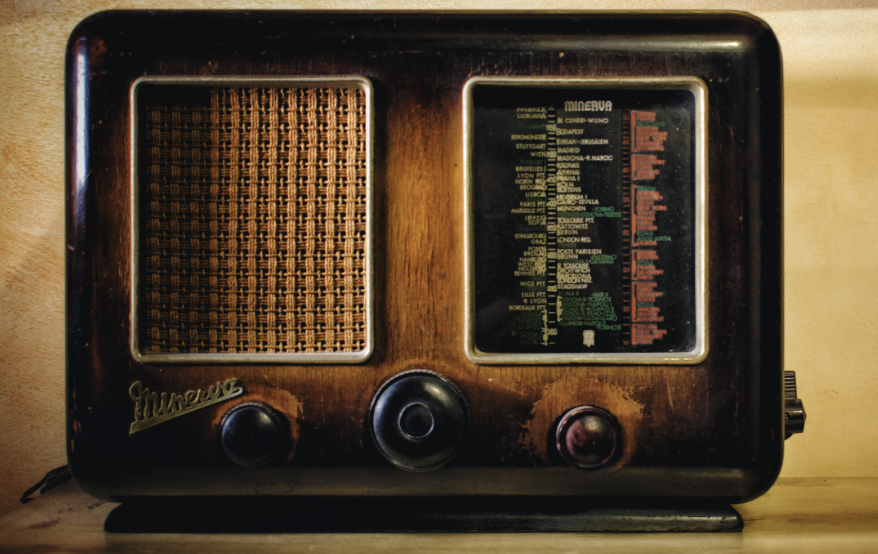
One of the strongest memories I have of home is walking into the kitchen around seven o’clock in the morning before school and coming upon my dad in his boxer briefs, listening to Morning Edition on WNYC. Our radio sits on top of the refrigerator and is dusty and cube-shaped like an old game console. Buttons for adjusting the station and volume decorate the sides. An orange screen flickers in the front with the wrong time that none of us attempt to fix. I think it’s been in that exact spot my entire life emitting the news, music, quiz shows, advertisements, speeches and debates, laughter and despair like an auditory Pandora’s box we dare not turn off. The radio even remains turned on when we leave for vacation, so the cats have something to listen to besides traffic and the drilling of concrete outside.
Listening to the radio remains a popular daily activity in the United States. According to a survey done by Nielsen Media Research in 2021, 88% of Americans listen to the radio every week compared to around 54% using social media. My dad actively uses both of these mediums.
More surprising is the amount of people in Gen Z who still listen to AM/FM radio. A survey done by Edison Research found that 55% of Gen Z listens to the radio daily, 89% through traditional radio and 11% through streaming radio. Being of the first generation of ‘digital natives’ (myself at the front of this group), I thought I would be practically alone among my peers because I don’t hear anyone under the age of thirty on it, but I guess this is simply not true.
However, one thing none of these studies on radio usage reported in depth how the radio is listened to, as in where it is coming from, whether hand-held or satellite radios or through an app or website accessible through smartphones and computers. The aesthetic or design of radios is something that really draws me to them as a communication technology. In Dr. Donald A. Norman’s bestselling book The Design of Everyday Things, he writes, “Good design is actually a lot harder to notice than poor design, in part because good designs fit our needs so well that the design is invisible, serving us without drawing attention to itself. Bad design, on the other hand, screams out its inadequacies, making itself very noticeable.” I could almost consider radios beautiful, but they are designed to be listened to, not to be looked at and admired (admired is a strong word), similar to the conceptual art of Marcel DuChamp — although the radio isn’t supposed to be ironic, no matter how it may appear. And if the design of a radio was more focused on its appearance as opposed to what takes place under its shell, it might register as a bad design no matter how pleasurable to my eyes it may be.
But it still annoys me how researchers and some scholars talk about radios as if they were invisible yet informative voices in the wind. It’s like discussing a novel without ever bringing up the novelist. I could only find one study commenting on the ‘object permanence’ of radios, so to speak, not really getting to the core of what I wanted to know—Nielsen Media Research reporting 69% of weekly radio consumption is done in cars in 2021, as most have radios built in. I believe this is important to know because without the appearance and aesthetic of the radio, the form may cease to stay the same. I’m afraid that the radio will blend into other forms of digital media like it, such as podcasts, which share the talk show element of radios, but lack the quintessentially small number of options.
Since moving away to college three years ago, I haven’t had a physical radio in my life to provide me with breaking news, corny jokes, and background noise—to be my electronic soul. I can listen to programs on my phone, but they’re usually drowned out by a constant trill of text messages and other notifications. WHYY is now occasional entertainment when folding laundry. Even if I had a physical radio, I couldn’t keep it on all the time because it would disrupt my suitemates and neighbors. And while NPR is available on his iPhone and computer, my dad prefers listening to that old radio on top of the refrigerator. He refuses to get rid of it and he’s tried the iPhone and computer, claiming that “it’s not the same.” To a certain degree, I agree with my dad. Everytime I listen to a station on my phone, something feels off or missing. Inauthentic is a feeling that pops into my head. Back home, our physical radio held the pitter-patter of life for my family together. It didn’t matter what was on, just that something was on.
